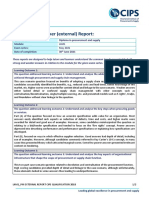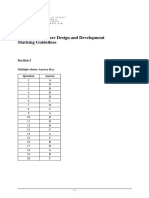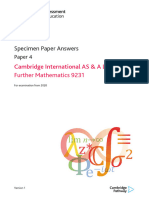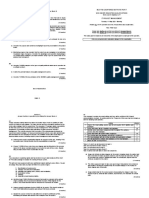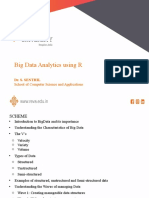Heq May21 Dip BDM Report
Heq May21 Dip BDM Report
Uploaded by
ASHEHU SANICopyright:
Available Formats
Heq May21 Dip BDM Report
Heq May21 Dip BDM Report
Uploaded by
ASHEHU SANIOriginal Title
Copyright
Available Formats
Share this document
Did you find this document useful?
Is this content inappropriate?
Copyright:
Available Formats
Heq May21 Dip BDM Report
Heq May21 Dip BDM Report
Uploaded by
ASHEHU SANICopyright:
Available Formats
BCS Higher Education Qualification
Diploma
MAY 2021
EXAMINERS’ REPORT
BIG DATA MANAGEMENT
General comments
Very few candidates attempted section A of the examination. Section (B) of the paper contained
the most popular questions. It covered the defining characteristics of Big Data – Laney’s v’s and
later extensions, volume, velocity, variety, valence, and value, typical measures of magnitude and
the challenges of Big Data – storage, infrastructure, technologies, processing.
Question number: A1
Syllabus area:
1 Big Data fundamentals
1.3 Challenges of Big data – storage, infrastructure, technologies, processing
3 Storage, data and programming interface models for Big Data
3.3 Data modelling – structured data, unstructured data and streamed data
3.4 Modelling real time data – pipelines with Kafka and similar technologies
Total marks allocated: 25
Examiners’ Guidance Notes
Most candidates achieved reasonably high marks for this question. For part a the essential
distinction between structured and unstructured data was answered. Part b was generally well
answered although some candidates did not address consistency as a main issue. Part c was well
answered with the key areas of Kafka comprehensively described by many. A few attempts
showed difficulty in going beyond a simple publish and subscribe definition and tended to gain
lower marks for this part of the question.
Question number: A2
Syllabus area:
2 Management issues for Big Data
2.1 Staffing, skillsets, strategies, total cost of ownership
5 Big Data infrastructures
5.1 Networks, cloud based – in house v outsourced
Total marks allocated: 25
Examiners’ Guidance Notes
Part a of this question was generally less well answered. Many answers tended to confuse the
costs and benefits between being an advantage or disadvantage and few answers mentioned any
advantage to having flexibility in development methods. For part b most answers indicated a good
appreciation of the three network properties but did not state how they can be optimised for Big
Data processing in particular. This reduced the potential to gain higher marks for this part of the
question.
Question number: A3
Syllabus area:
7 Introduction to R
7.2 R programming language – language and ecosystem basic syntax
7.3 Basic statistics in R – mode, mean, variance, moments
Total marks allocated: 25
Examiners’ Guidance Notes
No attempts were made for this question
Question number: B4
Total marks allocated: 25
Examiners’ Guidance Notes
This was a very well answered question with most candidates achieving high marks. A small
number of candidates did not provide sufficient depth in their answers
Question number: B5
Total marks allocated: 25
Examiners’ Guidance Notes
Candidates were able to demonstrate good knowledge on these topics. Nearly all provided
satisfactory or better answers
Question number: B6
Total marks allocated: 25
Examiners’ Guidance Notes
A reasonably well answered question. Again more depth in the answers would have helped
You might also like
- Iot-Based Big Data Storage Systems in Cloud Computing: Perspectives and ChallengesDocument13 pagesIot-Based Big Data Storage Systems in Cloud Computing: Perspectives and ChallengesSACHIN KUMARNo ratings yet
- Heq Nov20 Dip Oop ReportDocument3 pagesHeq Nov20 Dip Oop Reporthlt.ariapalaNo ratings yet
- Heq May21 Dip Oop ReportDocument3 pagesHeq May21 Dip Oop Reporthlt.ariapalaNo ratings yet
- Heq Oct22 Cert SD ReportDocument4 pagesHeq Oct22 Cert SD ReportDiei IsraelNo ratings yet
- Heq Oct21 Dip Oop ReportDocument4 pagesHeq Oct21 Dip Oop Reporthlt.ariapalaNo ratings yet
- Heq Oct22 Dip Oop ReportDocument3 pagesHeq Oct22 Dip Oop Reporthlt.ariapalaNo ratings yet
- Heq Oct23 Cert Is ReportDocument6 pagesHeq Oct23 Cert Is ReportDiei IsraelNo ratings yet
- Heq Apr22 Dip Oop ReportDocument3 pagesHeq Apr22 Dip Oop Reporthlt.ariapalaNo ratings yet
- Heq Oct23 Dip Oop ReportDocument3 pagesHeq Oct23 Dip Oop Reporthlt.ariapalaNo ratings yet
- Heq Oct22 Cert Is ReportDocument3 pagesHeq Oct22 Cert Is ReportDiei IsraelNo ratings yet
- Heq Apr23 Cert Is ReportDocument5 pagesHeq Apr23 Cert Is ReportDiei IsraelNo ratings yet
- Heq Apr23 Dip Oop ReportDocument2 pagesHeq Apr23 Dip Oop Reporthlt.ariapalaNo ratings yet
- Heq Apr22 Cert Is ReportDocument7 pagesHeq Apr22 Cert Is ReportDiei IsraelNo ratings yet
- 2021 MathDocument15 pages2021 MathShalini KulshresthaNo ratings yet
- Mathematics HL (Ibna & Ibla) : Component Grade BoundariesDocument12 pagesMathematics HL (Ibna & Ibla) : Component Grade BoundariesHamad JavedNo ratings yet
- Examiners Report Pure Mathematics and ComprehensionDocument21 pagesExaminers Report Pure Mathematics and ComprehensionUmair IslamNo ratings yet
- June 2022 Examiner ReportDocument23 pagesJune 2022 Examiner ReportLahek MirpuriNo ratings yet
- Information Technology Management Auditand ControlDocument2 pagesInformation Technology Management Auditand ControlabdullahNo ratings yet
- Heq Oct23 Cert CNT ReportDocument5 pagesHeq Oct23 Cert CNT ReportDiei IsraelNo ratings yet
- Course Syllabus QBA 301 Fall 2024Document6 pagesCourse Syllabus QBA 301 Fall 2024fkhalife14No ratings yet
- BMAN 10501 Feedback On Assessment - Jan 2017Document4 pagesBMAN 10501 Feedback On Assessment - Jan 2017PatNo ratings yet
- Paper 1 and 2 GuidanceDocument52 pagesPaper 1 and 2 GuidanceAnanya GuptaNo ratings yet
- Computing Examiners Reports JuneDocument13 pagesComputing Examiners Reports JuneKelvir3No ratings yet
- Laporan Pep 2018 IctDocument12 pagesLaporan Pep 2018 IctSHAHRUL NAJIB BIN ABDULLAH KPM-GuruNo ratings yet
- Advanced Level Computer Science 602301 November 2022 Examiner ReportDocument4 pagesAdvanced Level Computer Science 602301 November 2022 Examiner Reportwk4c65927rNo ratings yet
- June 2022 Examiner ReportDocument26 pagesJune 2022 Examiner Reportjustice NiiNo ratings yet
- Heq Apr22 Cert CNT ReportDocument4 pagesHeq Apr22 Cert CNT ReportDiei IsraelNo ratings yet
- External Assessment Report 2011: Physics Standard GradeDocument6 pagesExternal Assessment Report 2011: Physics Standard Grademuhai_232No ratings yet
- 2022 ATAR Course Examination Report PHYDocument3 pages2022 ATAR Course Examination Report PHYtomtomroro123No ratings yet
- Paper DescriptorDocument3 pagesPaper DescriptorsylevestermbereNo ratings yet
- L4M1 May 2021 PM External ReportDocument2 pagesL4M1 May 2021 PM External ReportMohammad Imran100% (1)
- Learning Management System Using PHP and Mysql: Adrian M. de Castro Bernadeth B. Rico Kenneth D. PinedaDocument26 pagesLearning Management System Using PHP and Mysql: Adrian M. de Castro Bernadeth B. Rico Kenneth D. PinedaNesty SarsateNo ratings yet
- Heq Oct22 Cert CNT ReportDocument4 pagesHeq Oct22 Cert CNT ReportDiei IsraelNo ratings yet
- The Institute of Chartered Accountants of PakistanDocument3 pagesThe Institute of Chartered Accountants of PakistanSuman UroojNo ratings yet
- Solved 1Document17 pagesSolved 1Muhammad MuddassirNo ratings yet
- Takehome-Midterm Exam-IS341-Database System (Theory) - Odd 2223Document3 pagesTakehome-Midterm Exam-IS341-Database System (Theory) - Odd 2223Ramdani DaniNo ratings yet
- Eduqas Gcse Electronics Spec From 2017 eDocument40 pagesEduqas Gcse Electronics Spec From 2017 ebqi98734No ratings yet
- Cambridge International AS & A Level: Sociology 9699/22 March 2020Document10 pagesCambridge International AS & A Level: Sociology 9699/22 March 2020redwanNo ratings yet
- Gcse Examiners' Reports: © Wjec Cbac LTDDocument19 pagesGcse Examiners' Reports: © Wjec Cbac LTDIan RatcliffNo ratings yet
- Information and Communication Technology: Paper 0417/11 TheoryDocument34 pagesInformation and Communication Technology: Paper 0417/11 TheoryFat boyNo ratings yet
- QMDM Course OutlineDocument3 pagesQMDM Course Outlinepulasta109No ratings yet
- BcaDocument9 pagesBcaRavinder SoniNo ratings yet
- ICT GCSE MarkingDocument8 pagesICT GCSE MarkingThomas BaynesNo ratings yet
- 2021 Vcaa ReportggggDocument16 pages2021 Vcaa Reportggggdyted73No ratings yet
- 2003-Nov IB Maths Paper 1Document13 pages2003-Nov IB Maths Paper 1Gloria TaylorNo ratings yet
- MarkDocument29 pagesMarkAriel SerenadoNo ratings yet
- Information and Communication Technology: Paper 0417/11 Theory 11Document35 pagesInformation and Communication Technology: Paper 0417/11 Theory 11advitsinghrathoreNo ratings yet
- May 2009 TZ2 Subject ReportDocument12 pagesMay 2009 TZ2 Subject ReportAastha NagarNo ratings yet
- Computer Application Technology GR 12 Exam Guidelines 2017 EngDocument14 pagesComputer Application Technology GR 12 Exam Guidelines 2017 Engmelun459No ratings yet
- ICCE 2023 Paper 129Document4 pagesICCE 2023 Paper 129rct.jhsdeptNo ratings yet
- 2003-Nov IB Maths Paper 1Document14 pages2003-Nov IB Maths Paper 1Gloria TaylorNo ratings yet
- Mathematical Studies: Mathematics Learning AreaDocument5 pagesMathematical Studies: Mathematics Learning AreaBobNo ratings yet
- Group 3, Grade 12 - GaisanoDocument24 pagesGroup 3, Grade 12 - Gaisanomamacleian2No ratings yet
- Data Communication & Networking (CEN-222)Document12 pagesData Communication & Networking (CEN-222)Nazif MalhiNo ratings yet
- Computer Science: Paper 9618/11 Theory FundamentalsDocument43 pagesComputer Science: Paper 9618/11 Theory Fundamentalsthompson11111111111No ratings yet
- 2021 Science Pes ReportDocument19 pages2021 Science Pes ReportPHENYONo ratings yet
- 2016 HSC Software Design and Development Marking Guidelines: Section IDocument20 pages2016 HSC Software Design and Development Marking Guidelines: Section IenjoylifeqdNo ratings yet
- MSA 2 Winter 2019 PDFDocument4 pagesMSA 2 Winter 2019 PDFSuman UroojNo ratings yet
- 9231 Specimen Paper Answers Paper 4 (For Examination From 2020)Document17 pages9231 Specimen Paper Answers Paper 4 (For Examination From 2020)westlakeray07No ratings yet
- Examiner Report PA2014Document21 pagesExaminer Report PA2014shuntat chanNo ratings yet
- Schoolsat BrochureDocument8 pagesSchoolsat BrochureASHEHU SANINo ratings yet
- Schoolsa NewDocument8 pagesSchoolsa NewASHEHU SANINo ratings yet
- Cluster - Location Phone - Number Gender First - Namesurname Middle - NameDocument359 pagesCluster - Location Phone - Number Gender First - Namesurname Middle - NameASHEHU SANINo ratings yet
- 774 RMKDocument3 pages774 RMKASHEHU SANINo ratings yet
- EmeraldInsight Citations 20220109213407Document1 pageEmeraldInsight Citations 20220109213407ASHEHU SANINo ratings yet
- Heq Smart Systems Sample PaperDocument3 pagesHeq Smart Systems Sample PaperASHEHU SANINo ratings yet
- Smart Systems: SyllabusDocument20 pagesSmart Systems: SyllabusASHEHU SANINo ratings yet
- 1 Bio-Csc Class List Nce 100L RegularDocument7 pages1 Bio-Csc Class List Nce 100L RegularASHEHU SANINo ratings yet
- Heq Smart Systems SyllabusDocument20 pagesHeq Smart Systems SyllabusASHEHU SANINo ratings yet
- Bcs Higher Education Qualifications BCS Level 5 Diploma in ITDocument2 pagesBcs Higher Education Qualifications BCS Level 5 Diploma in ITASHEHU SANINo ratings yet
- Section B Answer Section B Questions You Attempt in Answer Book BDocument2 pagesSection B Answer Section B Questions You Attempt in Answer Book BASHEHU SANINo ratings yet
- Principles of Internet Technologies: Bcs Level 5 Diploma in ItDocument17 pagesPrinciples of Internet Technologies: Bcs Level 5 Diploma in ItASHEHU SANINo ratings yet
- Agency BankingDocument4 pagesAgency BankingASHEHU SANI100% (1)
- 07 03 IITJ MBA Tech BrochureDocument29 pages07 03 IITJ MBA Tech BrochureYamit AgarwalNo ratings yet
- Data - Analytics - Unit - I - III MCA'A'Document207 pagesData - Analytics - Unit - I - III MCA'A'Imran AlamNo ratings yet
- EY Treasury Management Systems Overview PDFDocument86 pagesEY Treasury Management Systems Overview PDFpratikNo ratings yet
- BL-COMP-6103-LEC-1933T CURRENT Trends and IssuesDocument6 pagesBL-COMP-6103-LEC-1933T CURRENT Trends and Issuesaudrey mae faeldoniaNo ratings yet
- For Business. For Growth. For Life.: Apps LaunchDocument20 pagesFor Business. For Growth. For Life.: Apps LaunchSME Bank MalaysiaNo ratings yet
- Chapter 5Document45 pagesChapter 5HEMAMALINI JNo ratings yet
- Instructor Materials Chapter 2: Fundamentals of Data AnalysisDocument25 pagesInstructor Materials Chapter 2: Fundamentals of Data Analysisabdulaziz doroNo ratings yet
- PDF Anggaran Dasar Fokkermapi Baru DLDocument17 pagesPDF Anggaran Dasar Fokkermapi Baru DLIwan RidwanudinNo ratings yet
- IT2090 - Professional SkillsDocument3 pagesIT2090 - Professional SkillsThilin ThungeeshaNo ratings yet
- IoT QB AnsDocument25 pagesIoT QB Ansvijay amrutkarNo ratings yet
- Big Data Workshop-NIT ManipurDocument7 pagesBig Data Workshop-NIT ManipurabhishekNo ratings yet
- Netflix: Using Big Data To Drive Big Engagement: Unlocking The Power of Analytics To Drive Content and Consumer InsightDocument4 pagesNetflix: Using Big Data To Drive Big Engagement: Unlocking The Power of Analytics To Drive Content and Consumer Insightdavidrex97No ratings yet
- Newsql: Towards Next-Generation Scalable Rdbms For Online Transaction Processing (Oltp) For Big Data ManagementDocument11 pagesNewsql: Towards Next-Generation Scalable Rdbms For Online Transaction Processing (Oltp) For Big Data ManagementNhat NguyenNo ratings yet
- Uowd Program Selection Guide Mar v2 2024Document24 pagesUowd Program Selection Guide Mar v2 2024servermemmedov590No ratings yet
- Big Data Testing: Why & HowDocument1 pageBig Data Testing: Why & HowSarvesh ShrivastavaNo ratings yet
- Commerce 2ka3: Final ExamDocument53 pagesCommerce 2ka3: Final ExamKristelleNo ratings yet
- Big Data & AI in The Era IR 4.0 Edwin Purwandesi Stimik Esq 24 Desember2021Document38 pagesBig Data & AI in The Era IR 4.0 Edwin Purwandesi Stimik Esq 24 Desember2021ahlijatiNo ratings yet
- 50 Years of Data ScienceDocument23 pages50 Years of Data ScienceManuel PeñafielNo ratings yet
- Medical Knowledge ExtractionDocument14 pagesMedical Knowledge ExtractionAtif KhanNo ratings yet
- 2017 Automation Alley Technology Industry ReportDocument15 pages2017 Automation Alley Technology Industry ReportMark CavittNo ratings yet
- Reaching - 5G - Plateau - of - Productivity - Guavus - Ebook - 2019Document30 pagesReaching - 5G - Plateau - of - Productivity - Guavus - Ebook - 2019Juan Tarbes VergaraNo ratings yet
- Research in International Business and Finance: Yang Wang, Sui Xiuping, Qi ZhangDocument9 pagesResearch in International Business and Finance: Yang Wang, Sui Xiuping, Qi Zhanganhnguyen.31231021095No ratings yet
- Big Data and Data ScienceDocument6 pagesBig Data and Data ScienceAishwarya JagtapNo ratings yet
- Building Magazine - Feb:Mar 2017Document32 pagesBuilding Magazine - Feb:Mar 2017Chris FindlayNo ratings yet
- Module 2 BDADocument40 pagesModule 2 BDAARYA MURALI ECE-2020-24No ratings yet
- The Future of Software Development Methods: January 2018Document14 pagesThe Future of Software Development Methods: January 2018Mintishu TemesgenzNo ratings yet
- Pertemuan 3. Business Motivations and Drivers For Big Data AdoptionDocument16 pagesPertemuan 3. Business Motivations and Drivers For Big Data AdoptionMuhammad alifakbarNo ratings yet
- Editable Scheme of Work For Unit 3Document44 pagesEditable Scheme of Work For Unit 3new yearNo ratings yet
- Assigment 11Document19 pagesAssigment 11Sree Mathi SuntheriNo ratings yet






























